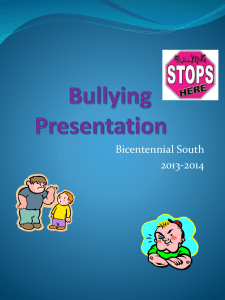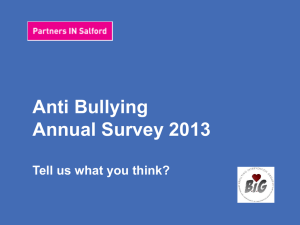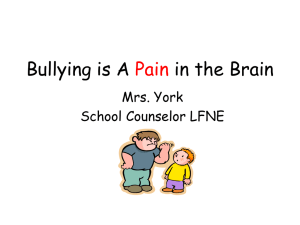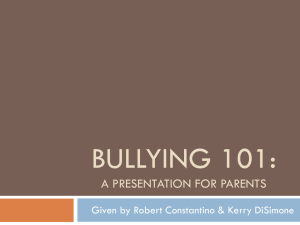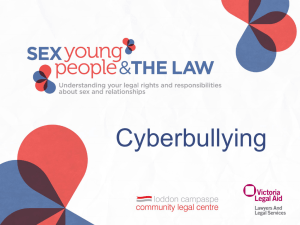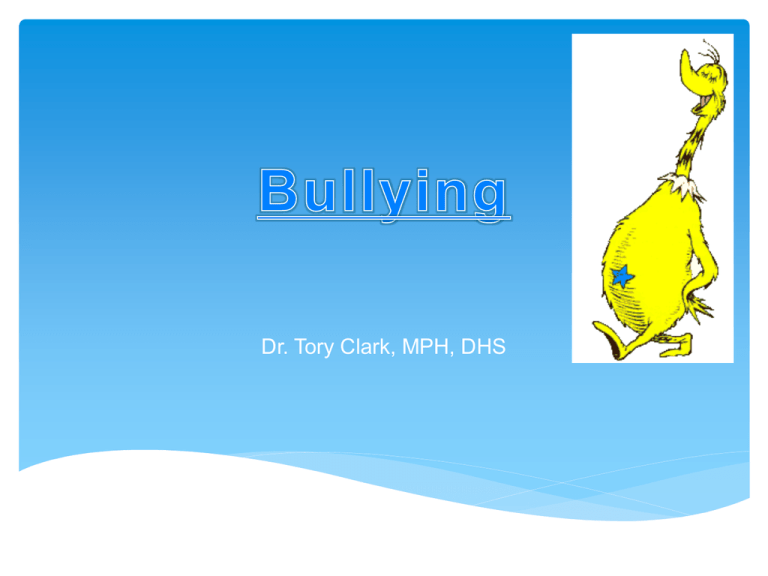
Dr. Tory Clark, MPH, DHS
Agenda
Define the different types of bullying
What’s going on in Washoe County
Etiology of bullying
Characteristics of bullies & victims of bullying
How you can help
Resources
Sneeches by Dr Seuss
Now, the Star-Belly Sneetches
had bellies with stars. The PlainBelly Sneetches had none upon
thars. Those stars weren’t so big.
They were really so small. You
might think such a thing wouldn’t
matter at all.
What is bullying?
Bullying is difficult to identify – Why?
Perception
Must be a power differential
Must be repeated
Actions must be intentional (Olweus, 1993)
Or not… Humor, teasing, no power differential,
no intention (Scaglinone & Scaglione, 2006)
Bullying by the Numbers
160,000- estimated number of U.S. students who skip
school daily to avoid being bullied
32%- students who report being bullied at school during
the school year
86%- gay or lesbian students who report being bullied
70%- teachers surveyed who say that educators
“almost always” intervene when bullying occurs
35%- 9th graders who believe their teachers are
interested in trying to stop bullying
66%- bullying victims who believe school professionals
responded poorly to the bullying they observed
10-20%- bystanders who provide any real help
www.tolerance.org/bullied
Is it happening here?
Climate Survey from WCSD
In the past 30 days in WCSD (student report) among students who
reported being bullied
24% physically bullied on bus
22% verbally bullied on the bus
13% physically bullied in school
27% verbally bullied in school
Percentage of students targeted at school (student report)by another
student
24% targeted about dress
44% targeted because of a physical characteristic
50% of MS employees rated bullying among students as a high
concern
Washoe County Climate Survey Report: http://bit.ly/H16w2k
In December, the district began to keep more specific
stats on cyberbullying and sexting.
Elementary school reports: 127
Middle school reports: 302
High school reports: 503
Online bullying reported by students and school staff in
Washoe County is up as much as 30 percent because
of a campaign to make students and parents more
aware of its effects, school officials and students say.
SB 276
State Sen. David Parks and and former state Sen.
Sheila Leslie, D-Reno, successfully sponsored Senate
Bill 276.
The bill included training programs for educator and
school staff on the prevention of bullying, cyber bullying,
harassment and intimidation in public schools.
It requires each school to create a safety team to
organize preventive and intervention training.
It also requires investigations of reported incidents and
calls for collaboration among the school board and the
school safety team to prevent, identify and address the
reported incidents.
Types of Bullying
Direct vs. Indirect
Verbal – Teasing, Name calling, racial names,
gossip
Physical – Threats or actual violence, pinching,
hitting, butt slapping
Social/Relational – Leaving someone out, gossip,
destroying reputation, manipulating relationships
Cyber bullying – Facebook, Twitter, email, text,
sexting
Hazing – rite of passage?
Cyber bullying
http://www.youtube.com/watch?v=ndTNnQIBbOA&feature=relmfu
Why is cyber bullying different from the other types of
bullying?
Anonymous, a global community, re-victimizes the
victim
The use of electronic forms of communication by an
individual or group to engage repeatedly in sending or
posting content about an individual or group that a
reasonable person would deem cruel, vulgar,
threatening, embarrassing, harassing, frightening, or
harmful (Beale & Hall, 2007).
Direct- messages are transmitted to the victim from the
bully
Indirect- the bully enlists others to bully the victim
Cyber Bullying Prevalence
90% of youth aged 12-17 yrs are active on the internet
on a daily basis(Pew Research Center)
More than 50% of youth 12-17 yrs have personal cell
phones (Raine, 2005).
Media usage, including time spent using a computer,
among 8-18 yr olds is up 2.25 hours in just the last 5
yrs. (Rideout, 2010)
50% had seen or heard of a website bashing of another
student
75% had visited a website bashing
Prevalence Cont’
90% of middle school students they polled had their
feelings hurt online
65% of their students between 8-14 have been involved
directly or indirectly in a cyber bullying incident as the
cyber bully, victim or friend
40% had their password stolen and changed by a bully
(locking them out of their own account) or sent
communications posing as them
What can you do about cyber
bullying?
Tell an administrator
Encourage parental involvement in monitoring their
son/daughter’s online usage
Advise the student to:
Stop
Save
Block
Tell
Sexting
Not just on phones- Sexting can be done on any
media-sharing device or technology - including email
and the Web. Teens have been convicted for child porn
distribution for emailing sexually explicit photos to each
other.
IT’S ILLEGAL! Sending nude or sexually suggestive
photos of oneself that is under age. May result in being
charged with producing or distributing child pornography
and having to register as a sex offender. If he/she keeps
them on their phone or computer they could be charged
with possession. If they go to someone in another state
(and that happens very easily), it is a federal felony.
Sexting cont’
Many Causes- In some cases, kids are responding to
peer pressure in a form of cyber bullying or pressure
from a boyfriend or girlfriend (they break up, and
sometimes those photos get sent around out of
revenge). Sometimes it's impulsive behavior, flirting, or
even blackmail. It's always a bad idea.
REPORT- Call Law enforcement immediately!
Tell them to stop, block and save!
Where does this behavior
come from????
But, because they had stars, all the Star-Belly
Sneetches Would brag, “We’re the best kind of Sneetch on the
beaches.” With their snoots in the air, they would sniff and
they’d snort “We’ll have nothing to do with the Plain-Belly
sort!” And, whenever they met some, when they were out
walking, They’d hike right on past them without even
talking. When the Star-Belly children went out to play
ball, Could a Plain Belly get in the game? Not at all. You only
could play if your bellies had stars And the Plain-Belly children
had none upon thars.
Etiology of Bullying
Social Learning Theory: children learn behaviors
from their environment and behaviors can then be
reinforced in different ways (Bandura, 1977).
Examples?
Aggression & violence from parents, media, peers
A child that grows up in a hostile environment views
the world as a hostile environment
Reinforcement acts as a propeller for violence and
leads to adult violence (Mihalic & Elliot, 1977).
Difference between boys and girls?
Benefit component
Etiology cont’
Studies have shown that children & adults may
behave more aggressively after viewing someone
else act aggressively
Students that are insecure view their bullying
classmates as more popular- they also see the
“benefits” that these students receive from the
behavior
Decreased sense of responsibility when more are
involved
Bystander effect….
Bullies are much like performers, she tells the crowd.
Their audience, she says, are bystanders, "just sitting
there watching, right? So they're not saying, 'fight,
fight, fight,' — but they're also not doing anything.”
"So who are they helping?" she asks. "The bully,
right?”
~ Erica Newell on NPR today
Etiology cont’
Attachment Theory: attachment in early life
provides a foundation for future behaviors, as a
child will continue to expect others to react to them
how their early caregivers did (Bowlby)
Adults who were bullied as children tend to have
difficulties with attachment in romantic relationships
and an increase in anxious attachment
Studies have shown that bullies are more likely to
develop anxious and insecure attachments than
non-involved children
Bullies acting out of insecurity
Characteristics of Bullies
Perceives solving problems through violence is positive
Popular & average to high self esteem
Difficulty controlling aggression
Often bullied or teased at home
Poor school performance
Drug or alcohol use
Gang affiliation
Despite popularity, bullies often lack close, long-term relationships
with friends
Long term concern of criminal behavior
Bullying children of either sex are more likely to have parents who
have marital problems or conflicts at home, have been bullies
themselves, exhibit inconsistent or over permissive approaches to
child rearing, and lack sensitivity to other people
Bullies are more likely to be hyperactive, disruptive, extroverted,
have higher neuroticism scores, lower IQs, and below-average
reading achievement than controls
Characteristics of Victims
Younger and physically smaller than their aggressor
Distress at home (parental abuse or misconduct)
Families of male victims tend to be over protective and close while families of
female victims tend to lean towards unhealthy emotional abuse
Unpopular at school among both peers and adults & worry about going to school
Passive victims are anxious, cautious, insecure and quiet – more likely to cry and
withdrawal when attacked
Low self esteem
Males – bad at sports
Shame
Depression
Low self esteem
Psychosomatic symptoms
Violence
As an adult
Social phobia, body image issues
Boys and girls bully differently
Both boys and girls bully verbally.
Boys may use more aggression, but this is
changing
Boys use more direct tactics – physically,
relationally
Girls are aggressive, but use more indirect tactics
Girls bully in groups
Girls are more likely to bully other girls (but will
bully boys) while boys will bully both girls and boys
Signs a kid is being bullied
Unexplainable injuries
Lost or destroyed clothing, books, electronics, or jewelry
Frequent headaches or stomach aches, feeling sick or
faking illness
Changes in eating habits, like suddenly skipping meals
or binge eating. Kids may come home from school
hungry because they did not eat lunch.
Difficulty sleeping or frequent nightmares
Declining grades, loss of interest in schoolwork, or not
wanting to go to school
Sudden loss of friends or avoidance of social situations
Feelings of helplessness or decreased self esteem
Self-destructive behaviors such as running away from
home, harming themselves, or talking about suicide
Signs a kid is bullying others
Get into physical or verbal fights
Have friends who bully others
Are increasingly aggressive
Get sent to the principal’s office or to detention
frequently
Have unexplained extra money or new belongings
Blame others for their problems
Don’t accept responsibility for their actions
Are competitive and worry about their reputation or
popularity
Why kids don’t ask for help
Bullying can make a child feel helpless. Kids may want
to handle it on their own to feel in control again. They
may fear being seen as weak or a tattletale.
Kids may fear backlash from the kid who bullied them.
Bullying can be a humiliating experience. Kids may not
want adults to know what is being said about them,
whether true or false. They may also fear that adults will
judge them or punish them for being weak.
Kids who are bullied may already feel socially isolated.
They may feel like no one cares or could understand.
Kids may fear being rejected by their peers. Friends can
help protect kids from bullying, and kids can fear losing
this support.
How YOU can help!
Empathy
“Empathy means entering the private perceptual
world of the other and becoming thoroughly at home
in it. It involves being sensitive, moment to moment,
to the changing felt meanings which flow in this other
person, to the fear or rage or tenderness or confusion
or whatever, that he/she is experiencing. It means
temporarily living in his/her life, moving about in it
delicately without making judgments…”
~ Carl Rogers
Solution-Focused Therapy
Kim Berg & Steve de Shazer
Focuses on solutions and the child’s resources,
with an emphasis on child developing strategies to
solve their problems.
Shift from being a victim to taking a stand creates
optimism, self-belief and hope that their situation is
changeable.
Short term, you don’t take sides or label students
bullies or victims, and does not presuppose
judgment on the cause of the behavior.
A team effort to change the climate within our
schools!
Case Study
Clara, a 12-year-old girl, presented to the school nurse
(Ann) in tears. She said that the boys in her class always
followed her during break times and were being nasty
towards her and calling her nick-names. The worst thing
for Clara was not having any friends at school. Clara
told the school nurse that she could not cope with this
situation anymore. The school nurse asked Clara if she
had any suggestions on how she could stop this name
calling and isolation, but Clara had none.
The following conversation then took place between Clara
& Ann.
Ann: ‘Can you remember any day that you enjoyed
being at school? What happened that day? Who were
you with?’
Clara: ‘Well, I remember one day two weeks ago
I enjoyed being at school because that day one of
the bullies was absent and Iris, a new girl, started in our
class. She did not know any other kids, so she asked
me if she could join me. That was a really nice day!’
Focus on past successes & exceptions to the problem
Ann: ‘Are there any other girls you like being with
in school?’
Clara: ‘Susan use to be nice to me when Alice was
not around and Cheryl in the other class can also
be nice sometimes.’
Exceptions to the problem
Ann: ‘Would it be okay for you if I asked these
girls along to a meeting with you in a group? We
can then discuss what to do to help you have a
better time at school?’
Clara: ‘I really would like that!’
Further strategy & plan for the future
If you have encountered a
bullying situation among
children/adolescents, how did
you handle it?
Questions??
Resources
LOCAL:
http://www.washoe.k12.nv.us/ - student section
Katherine Louden KLoudon@washoeschools.net
UNR Downing Clinic: 775-682-5515 William Raggio
Building Room 3007
Tory Clark toryclark@hotmail.com
www.flipthescriptnow.org
http://www.tolerance.org
http://www.stopbullying.gov/
http://cyberbully.org/
www.TheNationalCampaign.org/sextech
http://www.thetrevorproject.org/

